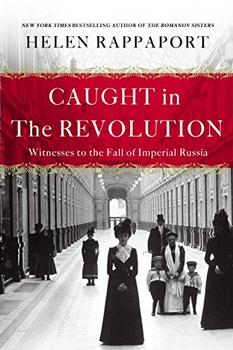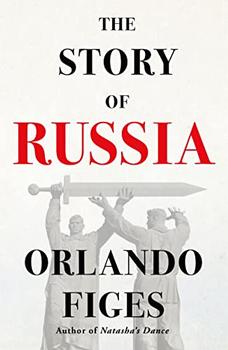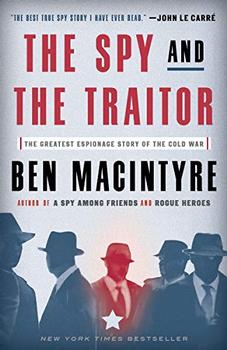Summary | Excerpt | Reviews | Beyond the book | Read-Alikes | Genres & Themes | Author Bio

Petrograd, Russia, 1917 - A World on the Edge
by Helen RappaportSo taken were BookBrowse's First Impression reviewers by the inside look at the start of the Russian Revolution, that a whopping 24 out of 25 of them gave Helen Rappaport's nonfiction book 4 or 5 stars. Here's why.
Readers appreciated the inside look at history
This is an absolutely fascinating book about the revolution that set up the Russia of today. It is 1917 and Tzar Nicholas abdicates under pressure. Caught in the Revolution focuses on the results of that abdication in Petrograd (modern-day St. Petersburg, see 'Beyond the Book) through contemporary letters and diaries of those stationed in embassies; of visitors; and other foreigners during the revolution (Sandra H).
Caught in the Revolution provides an up-close view of almost unbelievable extremes in early 20th century Russian society: peasants from the countryside and factory workers standing in the city's soup lines and sleeping in whatever shack or lean-to might lend shelter during a brutal winter; Russian soldiers who avoided slaughter on the battlefields of World War I and made it back to the capital; an elite aristocracy and nobility as well as members of the diplomatic corps of European and U.S. ambassadors and ministers who all led lavish lives, partying in palace homes and shopping in the most elegant shops on Nevsky Prospekt. The actions of the latter indicated a complete obliviousness to the desperate lives of the poor in nearby streets (Sheryl M).
Readers learned a lot by reading this book
I was fascinated by Rappaport's reporting, feeling as if I too were there, appalled, disbelieving and freezing. I learned about Russia and how the Bolsheviks destroyed the "old" ruling monarchy and about the rise of Lenin and Trotsky as I watched the destruction that led eventually to Putin's Russia, all more than any history course could have told me (Sandra H).
Most people know the basic story of the Russian Revolution and the end of the Romanov family, but there were many foreigners who were in Russia at the time and the book covers their observations and perspective. Many were aristocrats representing their respective governments and tended to have a lifestyle in Petrograd similar to that of the Czar, while others were reporters, writers, nurses and teachers who saw the rebellion grow among the citizens where lack of food and other necessities were common. Their stories are all woven together in a detailed, but very readable narrative (Jeff M).
Readers appreciated the stellar writing built on solid research
Author Helen Rappaport has done a prodigious amount of research on the start of the Russian Revolution in Petrograd in 1917. She has pored through letters, diaries and other documents of more than 80 foreign eyewitnesses and has over 60 pages of notes and bibliography. While gathering the material is one thing, she creates a cohesive story that keeps the reader's interest (Jeff M).
Helen Rappaport sorts out the chaos and establishes vivid and memorable images of each of the players "caught in the Revolution." Her non-fiction narrative has nothing in common with dry textbooks that most readers of this review might remember. The book reads more like popular and compelling fiction. More people would love the study of history if writers had Rappaport's skills that make this book such an engaging but thoroughly documented read (Sheryl M).
The book was challenging for a few...
This was not an easy book. Rappaport's many sources trace, in sometimes horrific detail, the hunger, the cold, the loss of civic order in Petrograd in 1917, and ultimately, the random and intentional violence on a city-wide scale as the Russian revolution gathers momentum. So quickly did stability crumble. So incredulous were the country's leaders about the underlying tensions growing out of decades of autocratic rule and the costs of staying in the First World War. And of course, I wondered whether such unrest could happen here (Todd E).
The thorough research by the author using excerpts from letters and diaries of eyewitnesses was amazing but I had to give up on referring to the numerous footnotes constantly cited in the text (Susan M).
History buffs, rejoice!
Caught in the Revolution should appeal to all history lovers but also to young students today who often think that history is boring. Book clubs will love this book. There are so many questions here to be fielded and discussed (Peggy K).
Sometimes you will have to refer to the glossary of the eyewitnesses or the detailed city maps, but if you are interested in the start of the Russian Revolution from the foreigner's perspective, this is the book for you (Jeff M).
![]() This review was originally published in The BookBrowse Review in March 2017, and has been updated for the
May 2018 edition.
Click here to go to this issue.
This review was originally published in The BookBrowse Review in March 2017, and has been updated for the
May 2018 edition.
Click here to go to this issue.

If you liked Caught in the Revolution, try these:

by Orlando Figes
Published 2023
From "the great storyteller of Russian history" (Financial Times), a brilliant account of the national mythologies and imperial ideologies that have shaped Russia's past and politics - essential reading for understanding the country today.

by Ben Macintyre
Published 2019
The celebrated author of Double Cross and Rogue Heroes returns with his greatest spy story yet, a thrilling Americans-era tale of Oleg Gordievsky, the Russian whose secret work helped hasten the end of the Cold War.
He has only half learned the art of reading who has not added to it the more refined art of skipping and skimming
Click Here to find out who said this, as well as discovering other famous literary quotes!
Your guide toexceptional books
BookBrowse seeks out and recommends the best in contemporary fiction and nonfiction—books that not only engage and entertain but also deepen our understanding of ourselves and the world around us.